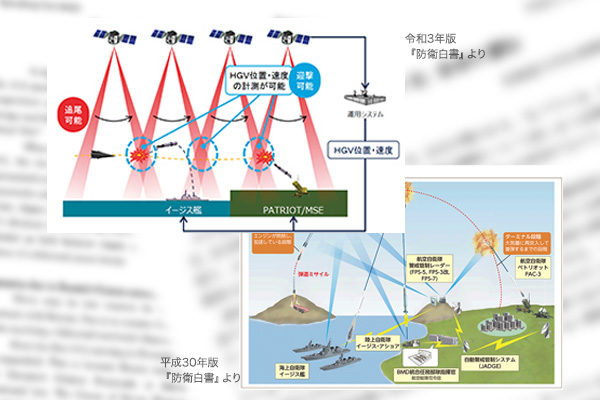On October 19, North Korea test-fired a submarine-launched ballistic missile that profiled an irregular trajectory in the atmosphere. On September 28, it test-fired a ground-launched Hwasong-8 missile alleged as a Hypersonic Glide Vehicle (HGV).
Russia in the latter half of the 1990s began to develop HGVs characterized by irregular trajectories as a game changer to break through ballistic missile defense. It has successfully test-fired HGVs from surface ships and submarines as well as from ground sites. According to the Financial Times, China test-fired a nuclear-capable HGV from an Earth orbit in August. In the United States, which has lagged slightly behind Russia and China in developing HGVs, its Army and Navy successfully tested HGVs on October 20. How is Japan planning to respond to these HGV developments?
Promoting satellite constellation research
Japan’s current ballistic missile defense consists of the Aegis system for intercepting ballistic missiles in outer space and the PAC-3 for intercepting them just before their landing. The Hwasong-8 fired by North Korea in September and the submarine-launched missile tested on October 19 cannot be intercepted by the Aegis system because they fly in the atmosphere. It is difficult to intercept them with the PAC-3 system because they profile irregular trajectories.
The Ministry of Defense has earmarked funding in its fiscal 2022 budget request for research on a satellite constellation program for detecting and tracking HGVs with many satellites in space, drones for long-time surveillance and reconnaissance, rail guns that can make a continuous firing of high initial velocity and HGV seekers.
When these technologies would become Initial Operational Capability is uncertain. At least until they are made available, Japan would need to have capability of attacking enemy missile launching sources. Would the Aegis system become meaningless if and when HGVs and other missiles projecting irregular trajectories in the atmosphere are realized? The answer is no. The Aegis system can intercept most of ballistic missiles from North Korea and many other countries.
Attack submarines should counter missile submarines
How should Japan respond to missile launches from submarines like what North Korea did on October 19? Submarines are roughly divided into two types – SSB for launching ballistic missiles and SS for attacking enemy submarines or surface ships. The 8.24 Yongung submarine, which North Korea reportedly used for the test firing, is an old SSB developed by the former Soviet Union during World War II, featuring extremely high noise levels. Such submarines going out into the open ocean would be detected by Japanese SSs and attacked by them just before firing missiles below the surface.
The U.S. Navy has deployed nuclear-powered attack submarines (SSNs) at Guam to be prepared for attacking Chinese nuclear-powered ballistic missile submarines (SSBNs) that could target the Continental U.S. from the South China Sea. The United States may hope to leave Japan to deal with obsolete North Korean submarines.
Fumio Ota is a senior fellow and a Planning Committee member at the Japan Institute for National Fundamentals. He is a retired Vice Admiral of Japan’s Maritime Self-Defense Force.


